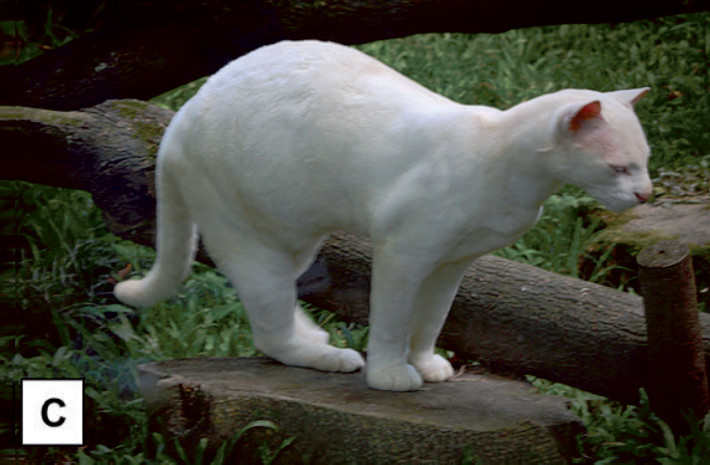First record of albinism in Leopardus pardalis (Linnaeus, 1758) in Colombia: conservation implications and captive management
DOI:
https://doi.org/10.31687/SaremNMS25.1149Palavras-chave:
captive care, genetic mutation, ocelot, wildlife conservationResumo
Albinism is a genetic condition characterized by the complete or partial absence of melanin, resulting in white or pink coloration of the skin, fur, and iris. In wild cats this condition may present additional survival challenges, particularly for activities such as hunting or camouflage. However, most cases of this phenomenon are documented in individuals kept in captivity. Here, we report the first documented case of complete albinism in a Leopardus pardalis (Linnaeus, 1758) in Colombia. The individual, a blind juvenile female, was rescued in 2021 in a biological corridor in the department of Antioquia and currently resides at the Parque de la Conservación in Medellín, where she receives specialized care due to her condition. This report highlights the distinct challenges this animal would likely face in the wild and emphasizes the critical importance of captive care in ensuring its survival.
Referências
Abreu, M. S. L., R. Machado, F. Barbieri, N. S. Freitas, & L. R. Oliveira. 2013. Anomalous colour in Neotropical mammals: a review with new records for Didelphis sp. (Didelphidae, Didelphimorphia) and Arctocephalus australis (Otariidae, Carnivora). Brazilian Journal of Biology 73:85–194. https://doi.org/10.1590/S1519-69842013000100020.
Aximoff, I. A., & C. A. Rocha. 2016. First records of albinism in greyheaded tayra (Carnivora, Mustelidae) and occurrence in high-altitude grassland in Brazil. Oecologia Australis 20(4):526–531. http://doi.org/10.4257/oeco.2016.2004.12.
Camacho, C., P. Sáez-Gómez, P. Hidalgo-Rodríguez, J. Rabadán-González, C. Molina, & J. J. Negro. 2022. Leucistic plumage as a result of progressive greying in a cryptic nocturnal bird. Scientific Reports 12(1):3411. https://doi.org/10.1038/s41598-022-07360-8.
Clubb, R., & S. Vickery. 2006. Stereotypies in carnivores: does pacing stem from hunting, ranging or frustrated escape? Stereotypic animal behaviour: fundamentals and applications to welfare (G. Mason & J. Rushen, eds.). CAB International, Oxfordshire and Boston.
da Silva, L. G., et al. 2017. Mapping black panthers: macroecological modeling of melanism in leopards (Panthera pardus). PLoS One 12(4):e0170378. https://doi.org/10.1371/journal.pone.0170378.
de Vasconcelos, F. T., et al. 2017. A novel nonsense mutation in the tyrosinase gene is related to the albinism in a capuchin monkey (Sapajus apella). BMC Genetics 18:1–6. https://doi.org/10.1186/s12863-017-0504-8.
Duquette, J. F., L. Ureña, J. Ortega, I. Cisneros, R. Moreno, & E. E. Flores. 2015. Evidence of albinism in the white-faced monkey Cebus capucinus imitator on Coiba Island, Republic of Panama. Neotropical Primates 22(2):97–99. https://doi.org/10.62015/np.2015.v22.143.
Espinal, M., J. M. Mora, L. A. Ruedas, L. I. López, & L. Marineros. 2016. A case of albinism in the Central American spider monkey, Ateles geoffroyi, in Honduras. Mastozoología Neotropical 23(1):63–69.
Graipel, M. E., L. G. R. Oliveira-Santos, F. V. B. Goulart, M. A. Tortato, P. R. M. Miller, & N. C. Cáceres. 2014. The role of melanism in oncillas on the temporal segregation of nocturnal activity. Brazilian Journal of Biology 74:S142–S145. https://doi.org/10.1590/1519-6984.14312.
Imes, D. L., L. A. Geary, R. A. Grahn, & L. A. Lyons. 2006. Albinism in the domestic cat (Felis catus) is associated with a tyrosinase (TYR) mutation. Animal Genetics 37(2):175–178. https://doi.org/10.1111/j.1365-2052.2005.01409.x.
Keller, L. F., & D. M. Waller. 2002. Inbreeding effects in wild populations. Trends in Ecology & Evolution 17(5):230–241. https://doi.org/10.1016/S0169-5347(02)02489-8.
Mackinven, K., & J. V. Briskie. 2014. Differential wear of feathers in the polymorphic New Zealand Fantail (Rhipidura fuliginosa)—a selective advantage of melanism? Emu – Austral Ornithology 114(2):154–159. https://doi.org/10.1071/MU13047.
Mazim, F. D., P. G. C. Wagner, J. A. May-Junior, S. Stefanello, P. Kuester, D. A. Spiazzi, & T. G. D. Oliveira. 2023. First record of melanism in the critically endangered Pampa cat (Leopardus munoai), an endemic species of the Pampa grasslands. Biota Neotropica 23:e20221456. https://doi.org/10.1590/1676-0611-BN-2022-1456.
Mériot, M., C. Hitte, M. Rimbault, C. Dufaure de Citres, V. Gache, & M. Abitbol. 2020. Donskoy cats as a new model of oculocutaneous albinism with the identification of a splice-site variant in Hermansky–Pudlak Syndrome 5 gene. Pigment Cell & Melanoma Research 33(6):814–825. https://doi.org/10.1111/pcmr.12906.
Mills, M. G., & L. B. Patterson. 2009. Not just black and white: pigment pattern development and evolution in vertebrates. Seminars in Cell & Developmental Biology 20(1):72–81. https://doi.org/10.1016/j.semcdb.2008.11.012.
Montilla, S. O., & A. Link. 2022. Albinism in a wild Caribbean night monkey (Aotus griseimembra) in a fragmented landscape in Colombia. Therya Notes 3:14–17. https://doi.org/10.12933/therya_notes-22-62.
Montoliu, L., et al. 2014. Increasing the complexity: new genes and new types of albinism. Pigment Cell & Melanoma Research 27(1):11–18. https://doi.org/10.1111/pcmr.12167.
Murray, J. L., & G. L Gardner. 1997. Leopardus pardalis. Mammalian Species 548:1–10.
Romero, V., C. E. Racines-Márquez, & J. Brito. 2018. A short review and worldwide list of wild albino rodents with the first report of albinism in Coendou rufescens (Rodentia: Erethizontidae). Mammalia 82(5):509–515. https://doi.org/10.1515/mammalia-2017-0111.
Schmidt-Küntzel, A., E. Eizirik, S. J. O'Brien, & M. Menotti-Raymond. 2005. Tyrosinase and tyrosinase related protein 1 alleles specify domestic cat coat color phenotypes of the albino and brown loci. Journal of Heredity 96(4):289–301. https://doi.org/10.1093/jhered/esi066.
Stumpp, R., D. Casali, H. Cunha, & A. Paglia. 2019. Complete albinism in Oxymycterus dasytrichus (Schinz 1821) (Rodentia: Cricetidae). Mammalia 83(3):281–286. https://doi.org/10.1515/mammalia-2018-0005.
Suárez-Ramírez, K. J. 2022. Evaluación de bienestar animal y comparación etológica entre dos individuos de Leopardus pardalis desde un enfoque de enriquecimiento ambiental albergados en el Parque de la Conservación, Medellín, Antioquia. Tesis de Pregrado. Universidad de Bogotá Jorge Tadeo Lozano, Santa Marta, Colombia.
Tokuda, M., A. L. M, Costa, C. Pessutti, L. Torrezan, L. L. Roca, N. Todesco, & R. H. F. Teixeira. 2021. Albinism in lowland tapir (Tapirus terrestris): a case of an orphaned calf tapir from Atlantic Forest. Brazilian Journal of Mammalogy 90:e90202136. https://doi.org/10.32673/bjm.vi90.36.
Van der Weyden, L., P. Caldwell, L. Van Rooyen, E. P. Mitchell, & N. O'Dell. 2021. Metastatic cutaneous melanoma in a white African lioness (Panthera leo). Veterinary Sciences 8(8):154. https://doi.org/10.3390/vetsci8080154.
Xu, X., et al. 2013. The genetic basis of white tigers. Current Biology 23(11):1031–1035. https://doi.org/10.1016/j.cub.2013.04.054.

Downloads
Publicado
Como Citar
Edição
Seção
Licença
Copyright (c) 2025 Julián Arango-Lozano, Karime Angarita-Corzo

Este trabalho está licenciado sob uma licença Creative Commons Attribution-NonCommercial 4.0 International License.

